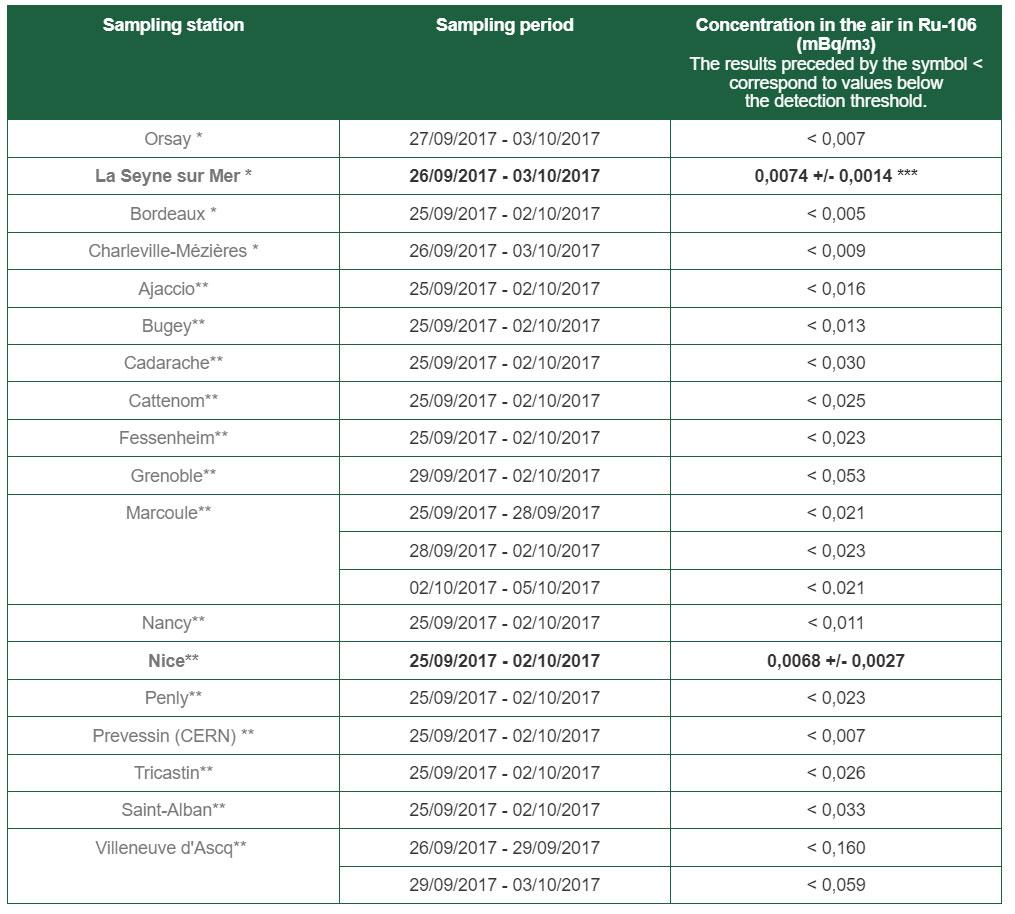Detection of ruthenium 106 in the air in the east and southeast of Europe - Update of October 9, 2017
Ruthenium-106 [1] has been detected by several European networks involved in the monitoring of atmospheric radioactive contamination, at levels of a few milliBecquerels per cubic meter of air.
IRSN has therefore undertaken investigations since October 3, 2017 to carry out an in-depth assessment of the measurements of ruthenium levels in the territory and to identify the possible origins of the situation encountered.
In France, IRSN has mobilized all its measurement stations for atmospheric monitoring and undertook the analysis of their filter samples [2]. At this stage, only the filters of the stations of Seyne-sur-Mer (Var) and Nice (Alpes-Maritimes) show the presence of ruthenium-106 at trace levels (respectively 7.4 and 6.8 micro-Bq/m3). The results of measurement of the filters of the other stations of IRSN do not show the presence of this radionuclide. All the measurement results are shown in the table 1 below.
Based on calculations carried out by IRSN, the levels of atmospheric contamination with ruthenium-106 of the order of those observed in Europe are not likely to generate health effects.
By combining levels of contamination observed and numerical simulations performed by IRSN, it appears that the contaminated air masses measured in Europe originate from the southern regions of the Urals. Given the amount of ruthenium-106 that may be at the origin of the air pollution observed in Europe, it appears that measures of protection of the populations could have been necessary in the vicinity of the site of the releases. It should be noted that the detection of ruthenium alone excludes the possibility of an accident on a nuclear power plant, which would result in the presence of other radionuclides. Ruthentium can occur in nuclear fuel cycle installation, in facilities manufacturing radioactive sources or in RTG's (Radioisotope thermoelectric generators) used for the power supply of satellites. Discussions with BfS, the German counterparts of IRSN, show that they reach similar conclusions.
At this stage, IRSN does not have information to confirm the end of the releases.
IRSN is continuing its efforts to monitor the level of ruthenium in the territory and its calculations to clarify the origin of the releases and their characteristics.
Notes:
- Ruthenium 106 is a radionuclide of artificial origin. It is a fission product from the nuclear industry. This radionuclide is also used in the medical field for brachytherapy treatments.
- In France, IRSN is responsible for monitoring the radioactivity of the atmosphere on a nation-wide scale. Its surveillance network OPERA-Air includes high-volume aerosol samplers (700 to 900 m3 of air per hour) and measurement equipment capable of detecting trace amounts of radioactivity.
Detection of RU-106 in Europe: Update of measurement results at IRSN's stations as of October 9, 2017

* Stations located in the localities marked with an asterisk have very high air filtration flows (up to 700 m3/ h) dedicated to the detection of traces.
** Stations located in localities marked with two asterisks have air filtration rates of 80 m3 / h.
*** The filter of La Seyne sur Mer station was re-measured during the weekend to confirm the value and reduce the uncertainty of the result.
